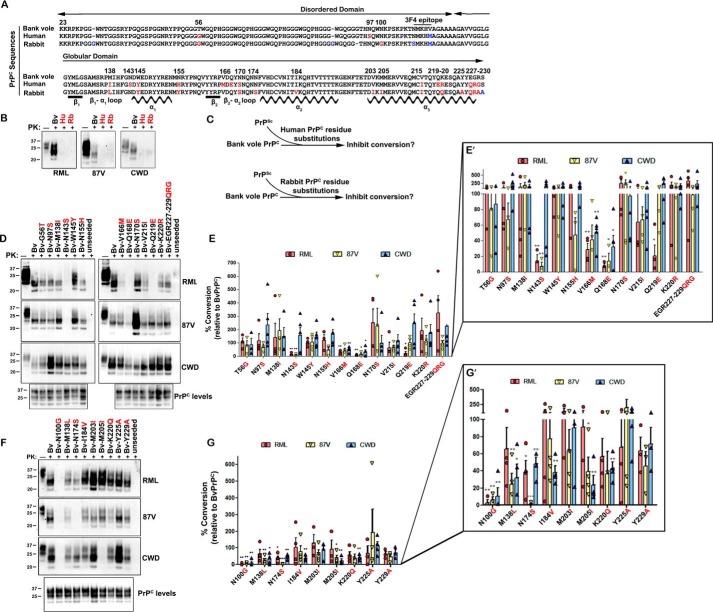Figure 1.
Human and rabbit amino acid substitutions inhibit conversion of bank vole PrPC. A, alignment of the PrPC sequences from bank vole, human, and rabbit reveals amino acid sequence differences between species at 27 positions (labeled in red and blue), 21 of which were investigated here (in red). Locations of the β-strands and α-helices are shown. B, mouse RML, mouse 87V, and elk CWD prions convert bank vole BvPrPC, but not HuPrPC or RbPrPC. C, schematic for experimental approach. BvPrPC with HuPrPC or RbPrPC substitutions was seeded with mouse or elk prions, and the newly converted PrPSc was measured after 24 h. D, representative immunoblots show conversion of BvPrPC with amino acid substitutions from HuPrPC. E, quantitative analysis shows that substitutions N143S, Q168E, and Q219E strongly inhibit BvPrPC conversion, depending on the PrPSc seed. F, representative immunoblots show conversion of BvPrPC with amino acid substitutions from RbPrPC. G, quantitative analysis shows that the N100G and N174S substitutions strongly inhibit conversion, depending on the PrPSc seed. E′ and G′ show the quantified data with a segmented y axis. For A, the GenBankTM accession numbers for bank vole, human, and rabbit PrPC are AF367624, DQ408531, and U28334, respectively. Quantified data are from three to five independent experiments (E and G). The error bars indicate the observed variance. *, p < 0.05; **, p < 0.01; ***, p < 0.001, one-sample t test. One-way ANOVA with Tukey post hoc test revealed statistically significant differences for CWD between residue substitutions at positions 100 and 203, positions 138 and 225, and positions 205 and 225 (*, p < 0.05), as well as between residues 100 and 225 (**, p < 0.01).

